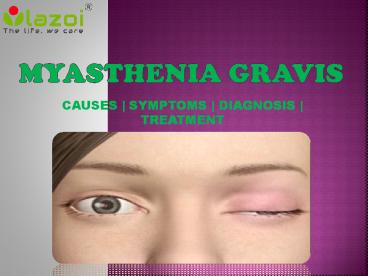Myasthenia Gravis: Symptoms, Causes, diagnosis and treatment. - PowerPoint PPT Presentation
Title:
Myasthenia Gravis: Symptoms, Causes, diagnosis and treatment.
Description:
Myasthenia Gravis is a neuromuscular disorder primarily characterized by muscle weakness and muscle fatigue. Although the disorder usually becomes apparent during adulthood, symptom onset may occur at any age. – PowerPoint PPT presentation
Number of Views:600
Title: Myasthenia Gravis: Symptoms, Causes, diagnosis and treatment.
1
Myasthenia Gravis
- CAUSES SYMPTOMS DIAGNOSIS TREATMENT
2
Introduction to Myasthenia Gravis
- Myasthenia Gravis is a neuromuscular disorder
primarily characterized by muscle weakness and
muscle fatigue. Although the disorder usually
becomes apparent during adulthood, symptom onset
may occur at any age. - The condition may be restricted to certain
muscle groups, particularly those of the eyes
(ocular myasthenia gravis), or may become more
generalized (generalized myasthenia gravis),
involving multiple muscle groups. - Most individuals with myasthenia gravis develop
weakness and drooping of the eyelids (ptosis)
weakness of eye muscles, resulting in double
vision (diplopia) and excessive muscle fatigue
following activity.
3
Causes of Myasthenia Gravis
- Myasthenia Gravis is a neuromuscular
disorder that is usually caused by an autoimmune
problem. - Autoimmune disorders occur when the immune system
mistakenly attacks healthy tissue. - In this condition, antibodies (proteins which
normally attack foreign, harmful substances in
the body) attack the neurotransmitter substance
called acetylcholine, which is a crucial
substance for nerve cell and muscle
communication. - This results in the muscle weakness that
characterizes the condition. The exact cause of
this autoimmune reaction is unclear to the
doctors.
4
Symptoms of Myasthenia Gravis
- Symptoms may include
- Trouble talking
- Problems walking up stairs or lifting objects
- Facial paralysis
- Difficulty breathing because of muscle weakness
- Difficulty swallowing or chewing
- Fatigue
- Hoarse voice
- Drooping of eyelid
- Double vision
5
Diagnosis of Myasthenia Gravis
- Your doctor will perform a complete physical
exam, as well as take a detailed history of
symptoms. He or she will also do a neurological
exam. This may consist of Checking your
reflexes - Looking for muscle weakness
- Checking for muscle tone
- Making certain your eyes move properly
- Testing sensation in different areas of your body
- Seeing if you can perform certain movements, like
touching your finger to your nose
6
Diagnosis Continue
- Other tests that can help your doctor diagnose
the condition include - Repetitive nerve stimulation test
- Blood testing for antibodies associated with
Myasthenia Gravis - Edrophonium (Tensilon) test a drug called
Tensilon (or a placebo) is injected, and the
patient is asked to perform muscle movements
under doctor observation - Imaging of the chest, using CT scans or MRI, to
rule out a tumour
7
Treatments of Myasthenia Gravis
- Common treatments for myasthenia gravis include
- Medications such as Mestinon (pyridostigmine
bromide) and Prostigmin (neostigmine bromide) - Corticosteroid medications such as prednisone
- Medications that suppress the immune system, such
as Imuran (azathioprine) and cyclosporine - Removal of the thymus gland (thymectomy), the
main gland in the immune system - Plasma exchange (plasmapheresis), in which the
person's blood plasma containing the abnormal
antibodies is removed and fresh plasma is put
back
8
Preventions of Myasthenia Gravis
- Myasthenia gravis cannot be prevented, but
avoiding the following triggers may help patients
prevent exacerbation - Emotional stress
- Exposure to extreme temperatures
- Fever
- Illness (e.g., respiratory infection, pneumonia,
tooth abscess) - Low levels of potassium in the blood
(hypokalemia caused by diuretics, frequent
vomiting) - Medications (e.g., muscle relaxants,
anticonvulsants, certain antibiotics) - Overexertion































